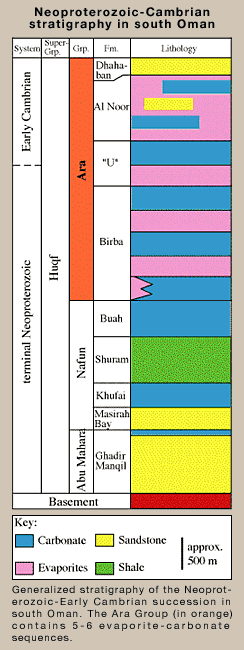
Salt
basins in Oman contain a well-preserved sedimentary sequence
of Late Neoproterozoic-Early Cambrian age. More specifically,
the evaporite-carbonate sequences of the Ara Group in Oman provide
a complete record of sedimentary, biological and geochemical
events at the boundary. Some key observations include:


Platform carbonates are significant hydrocarbon reservoirs;
microbial reefs within the carbonates contain some of the earliest
metazoan fossils (
Cloudina and
Nama- calathus).


The
carbonates record a prominent negative carbon isotopic excursion
and an unusual enrichment of uranium. Coeval ash beds have been
dated at MIT's
geochronology
laboratory. The dates confirm the correlation with the
global carbon isotopic excursion at the Precambrian/Cambrian
boundary.


Evaporites of the Ara Group are characterized by heavy sulfur isotopes, comparable to observations from other evaporite basins of that period.


During deposition of the platform carbonates, the surrounding basinal areas were probably characterized by largely anoxic water masses. The basins filled with organic-rich cherts (Athel silicilyte) that are important hydrocarbon source rocks. Anoxic waters may have flooded platform areas periodically.

Maps of Oman (below) and the study area in the South Oman Salt Basin (below right). The South Oman Salt Basin is subdivided into two platform domains, separated by a deep, probably anoxic basin. The Ara evaporite-carbonate sequences are labelled A1 to A6. Research focuses on the A4/Athel interval at the Precambrian/Cambrian boundary. Oman map after Loosveld et al. (1996).
These observations suggest profound biological and geochemical changes. Our current research focuses on the processes behind these changes and how they are linked to each other. The main research areas are:


Redox-sensitive
trace metals and organic carbon isotopes are analyzed in order
to understand the redox conditions in platform carbonates and
organic-rich basinal cherts. They can also be helpful in tying
together the geochemical archives from platform and basin locations.
Collaboration with Ed Boyle of MIT.


Analysis of Re-Os isotopes in the organic-rich cherts as an additional archive of redox conditions and for radiometric dating. Collaboration with Greg Ravizza and Bernhard Peucker-Ehrenbrink, Woods Hole Oceanographic Institution.


The geochemical signature of organic compounds should reflect biochemical
processes in the water column. Collaboration with
Roger
Summons of MIT.


In addition, the fabrics and the metazoan component of the microbial carbonate reefs are studied to better understand how they reflect the changes recorded by the various geochemical archives. Fabrics are also compared to coeval microbial reefs in Namibia.




